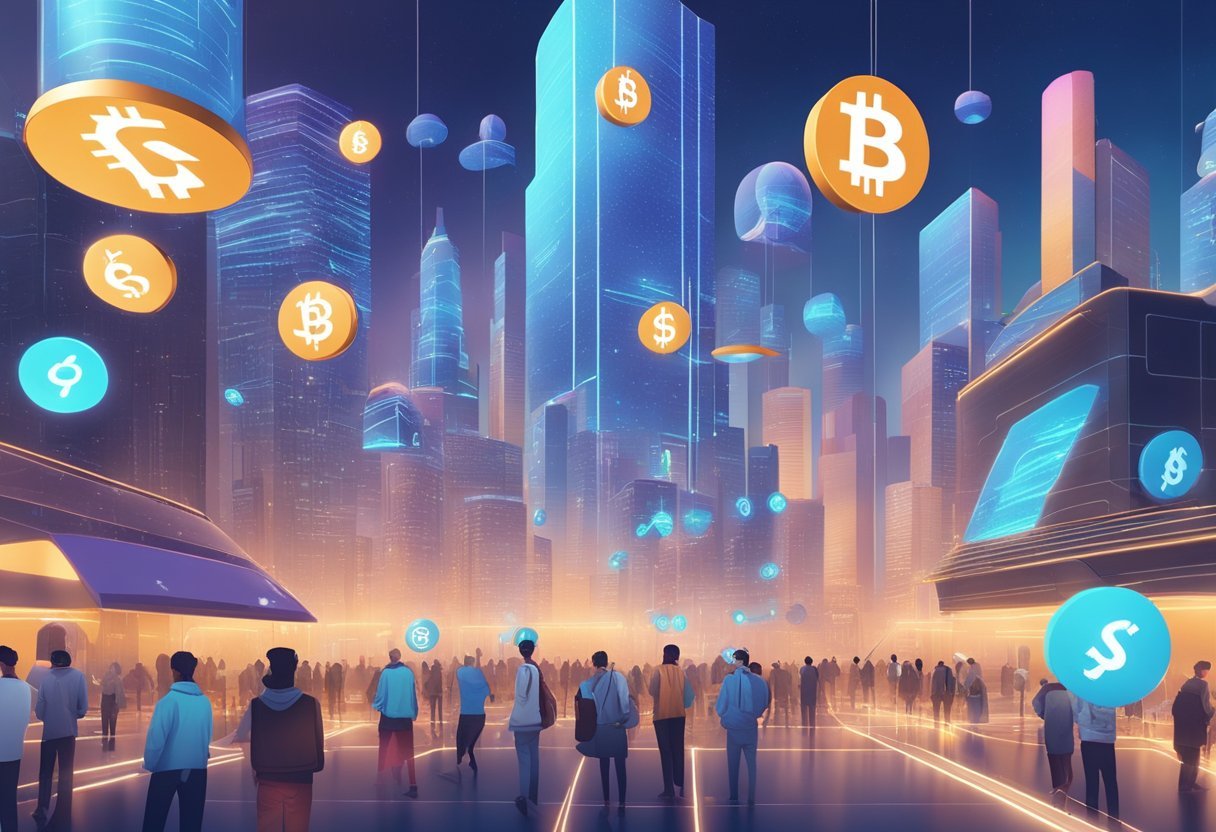Metaverse payments are a form of digital transactions that take place within virtual worlds. With the rise of blockchain technology, cryptocurrencies, and the growing interest in virtual reality, metaverse payments are becoming increasingly popular. In the metaverse, users can buy and sell virtual goods, services, and experiences using digital currencies.
Understanding metaverse payments is essential for anyone looking to participate in virtual worlds. Security and fraud prevention are also critical considerations when it comes to metaverse payments. As the metaverse continues to grow and evolve, it is important to stay up-to-date on market dynamics and ecosystem changes. Future trends in metaverse payments are likely to be influenced by factors such as technological advancements, regulatory changes, and user adoption.
Key Takeaways
- Metaverse payments are a growing form of digital transactions that take place within virtual worlds.
- Understanding security and fraud prevention is crucial for safe and secure metaverse payments.
- Keeping up-to-date on market dynamics and ecosystem changes is essential for staying informed about metaverse payments.
Understanding Metaverse Payments
What is Metaverse Payments?
Metaverse payments refer to the use of digital currencies or tokens in virtual worlds, also known as the metaverse. It is a new way of conducting transactions within these virtual worlds, allowing users to buy and sell virtual goods and services.
How does payments work in the Metaverse?
Payments in the metaverse are made through digital wallets and payment rails, which are integrated into the virtual world. Users can purchase virtual goods using cryptocurrencies, stablecoins, or other digital currencies. Transactions are verified and recorded on a blockchain, ensuring transparency and security.
How do I receive payments in the Metaverse?
To receive payments in the metaverse, users need to set up a digital wallet that is compatible with the virtual world they are using. The wallet will generate a unique address that can be used to receive payments from other users. Once the payment is received, it is recorded on the blockchain and can be used to purchase other virtual goods or exchanged for fiat currency.
The Role of Cryptocurrencies
Cryptocurrencies play a significant role in metaverse payments, as they are used to purchase virtual goods and services. They offer a decentralized and secure way of conducting transactions, without the need for intermediaries.
Digital Wallets and Payment Rails
Digital wallets and payment rails are essential components of metaverse payments. They allow users to store and manage their digital currencies, as well as make and receive payments within the virtual world. Payment rails facilitate the transfer of funds between users, ensuring that transactions are fast and secure.
The Impact of Blockchain Technology
Blockchain technology is a crucial component of metaverse payments, as it provides a secure and transparent way of recording transactions. It allows users to verify transactions without the need for intermediaries, ensuring that payments are fast, secure, and cost-effective.
In summary, metaverse payments are a new way of conducting transactions within virtual worlds, using digital currencies and payment rails. Cryptocurrencies, digital wallets, and blockchain technology play a significant role in facilitating these transactions, ensuring that they are secure, transparent, and fast.
Security and Fraud Prevention

Combatting Fraud and Chargebacks
To ensure secure transactions in the metaverse, combatting fraud and chargebacks is crucial. As the metaverse expands, so does the risk of fraud and scams. Fraudsters may use various tactics to exploit the system, including phishing, identity theft, and chargebacks. To prevent these risks, metaverse payment platforms should implement robust security measures such as two-factor authentication, real-time fraud monitoring, and chargeback protection.
Regulation and Compliance
Regulation and compliance are essential to ensure security and prevent fraud in the metaverse. As the metaverse evolves, it is crucial to stay updated on the latest regulations and compliance requirements. Payment platforms should comply with the relevant laws and regulations, including KYC (Know Your Customer) and AML (Anti-Money Laundering) regulations. This includes verifying the identity of users and monitoring transactions for suspicious activity.
KYC and Anti-Money Laundering
KYC and Anti-Money Laundering regulations are critical to prevent fraud and money laundering in the metaverse. Payment platforms should verify the identity of users and monitor transactions for suspicious activity. This includes tracking the source and destination of funds, monitoring for unusual transaction patterns, and reporting suspicious activity to the relevant authorities. By complying with KYC and AML regulations, payment platforms can help ensure the safety and security of the metaverse payment ecosystem.
Market Dynamics and Ecosystem

User Experience and Access
The user experience and access to metaverse payments are critical factors in the success of the ecosystem. Metaverse payments need to be seamless, secure, and easy to use to encourage mass adoption. The user interface should be intuitive, and payment options should be flexible and diverse to cater to different user preferences. Accessibility is also a critical factor, and metaverse payments should be available to users regardless of their location or device.
Retail and Merchant Adoption
Retail and merchant adoption is crucial for the growth of metaverse payments. Retailers need to integrate metaverse payments into their existing payment systems to provide users with a seamless shopping experience. Merchants should also be incentivized to accept metaverse payments by providing them with lower transaction fees and faster settlement times. Metaverse payments also provide retailers with opportunities to sell NFTs and other digital assets, which can help increase revenue.
Competition and Collaboration
The metaverse payments ecosystem is highly competitive, with players such as Amazon and PPRO vying for market share. Collaboration is also essential, and players need to work together to create interoperable payment systems that can cater to the diverse needs of users. Competition and collaboration can drive innovation and improve the overall user experience.
In summary, the success of metaverse payments depends on various factors, including user experience, retail and merchant adoption, and collaboration among players. Metaverse payments have the potential to revolutionize the digital payments industry and create new opportunities for retailers and merchants.
Future Trends in Metaverse Payments

The Evolution of Digital Assets
The rise of digital assets and non-fungible tokens (NFTs) has brought about a new era of value exchange in the metaverse. As the metaverse continues to grow, digital assets will become even more important as a means of exchange. The adoption of blockchain technology has enabled digital assets to be securely traded and transferred, making them a viable alternative to traditional payment methods.
The emergence of NFT marketplaces has made it easier for users to buy, sell, and trade digital assets. This has led to an increase in the use of cryptocurrency and stablecoins for metaverse payments. As more users adopt digital assets, it is likely that we will see a shift away from traditional payment methods.
Integrating Web 3.0 and Virtual Reality
Web 3.0 is the next generation of the internet, which promises to be more decentralized, secure, and user-centric. The integration of Web 3.0 and virtual reality will enable users to interact with the metaverse in new and exciting ways. This will include the ability to make payments seamlessly within virtual reality environments.
One of the challenges of integrating Web 3.0 and virtual reality is the risk of phishing attacks. As more users adopt digital assets, it is important to ensure that they are protected from fraud and theft. The development of secure payment protocols and user-friendly interfaces will be crucial in ensuring the safe and widespread adoption of metaverse payments.
In conclusion, the future of metaverse payments looks promising as the adoption of digital assets and blockchain technology continues to grow. The integration of Web 3.0 and virtual reality will enable users to make payments seamlessly within virtual reality environments. However, it is important to ensure that users are protected from fraud and theft through the development of secure payment protocols and user-friendly interfaces.

Frequently Asked Questions
How will transactions be handled securely within the metaverse?
Transactions in the metaverse will be handled securely through the use of blockchain technology. Blockchain provides a decentralized and secure way to process transactions without the need for intermediaries. This ensures that transactions are fast, secure, and tamper-proof.
What currencies will be accepted for payments in the metaverse?
In the metaverse, users can use a variety of currencies for payments. This includes traditional fiat currencies such as USD, as well as cryptocurrencies like Bitcoin and Ethereum. Additionally, some virtual worlds may have their own currencies, which can be used for in-world transactions.
Can digital wallets used for cryptocurrencies be integrated for metaverse payments?
Yes, digital wallets used for cryptocurrencies can be integrated for metaverse payments. This allows users to easily make payments using their preferred cryptocurrency.
What are the implications of blockchain technology on metaverse transactions?
Blockchain technology has significant implications for metaverse transactions. It provides a secure and transparent way to process transactions without the need for intermediaries. This means that transactions can be processed quickly and securely, with minimal fees.
How can users ensure privacy and data protection when making payments in the metaverse?
Users can ensure privacy and data protection when making payments in the metaverse by using secure payment methods and by being careful with their personal information. Additionally, some virtual worlds may have their own privacy and data protection policies in place.
What are the challenges and solutions for cross-platform payment systems in the metaverse?
One of the main challenges for cross-platform payment systems in the metaverse is interoperability. To address this, some virtual worlds are working on developing interoperable payment standards and protocols. Additionally, some payment providers are developing solutions that can be used across multiple virtual worlds.
How will people pay in the metaverse?
People will be able to pay in the metaverse using a variety of payment methods, including credit cards, cryptocurrencies, and virtual world currencies. Additionally, some virtual worlds may have their own payment methods and systems in place.
What payment providers are in the metaverse?
There are several payment providers in the metaverse, including PayPal, Stripe, and Square. Additionally, some virtual worlds may have their own payment providers and systems in place.
How does metaverse money work?
Metaverse money works similarly to traditional money, but it is used exclusively within virtual worlds. Users can earn, buy, and sell metaverse money, which can be used to purchase virtual goods and services.
What is metaverse money called?
Metaverse money is called by different names depending on the virtual world. For example, in Second Life, the virtual currency is called Linden Dollars, while in Decentraland, it is called MANA.
Is metaverse money laundering?
Metaverse money laundering is a concern in virtual worlds, just as it is in the real world. Virtual worlds are working to develop policies and procedures to prevent money laundering and other illegal activities.




